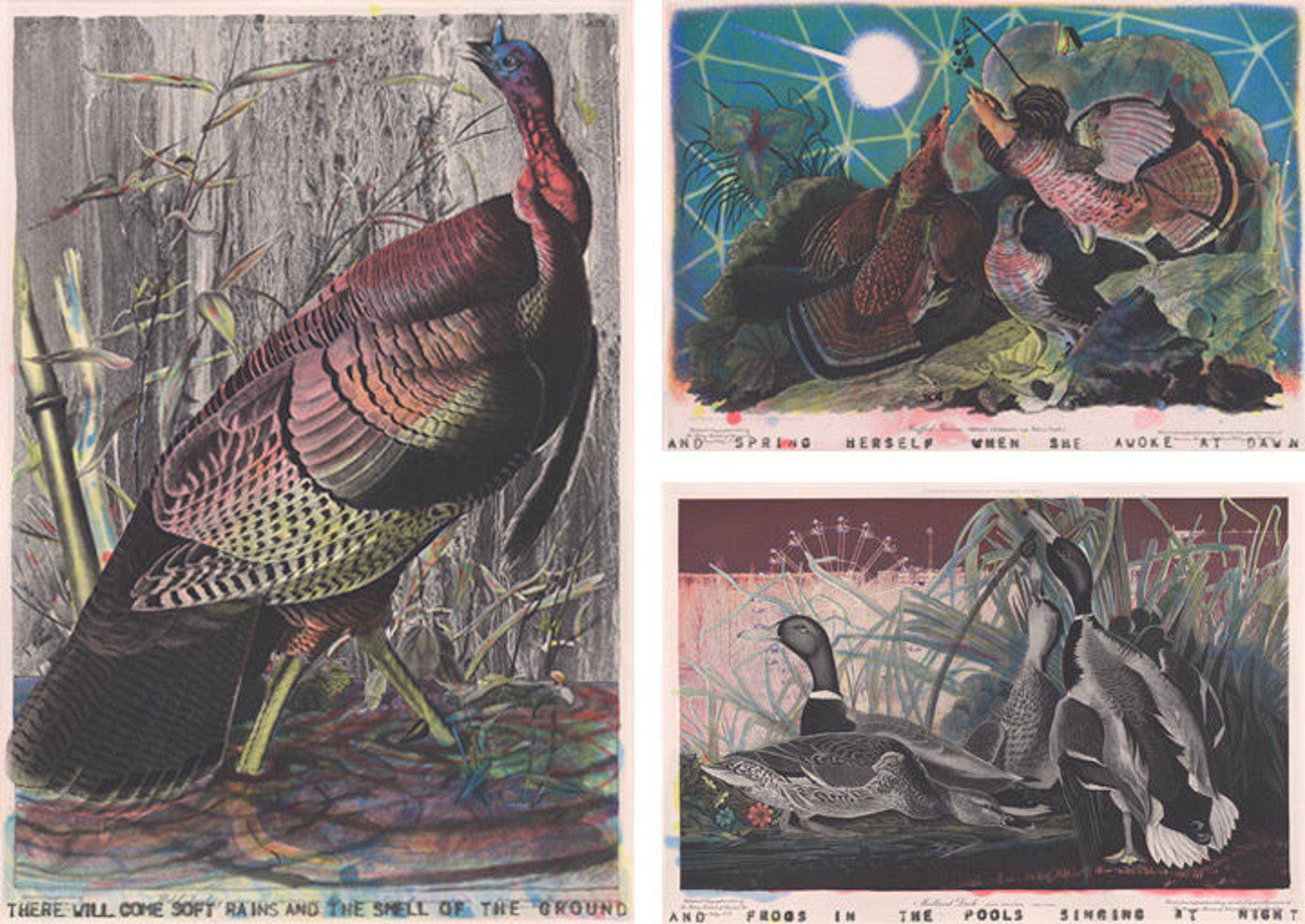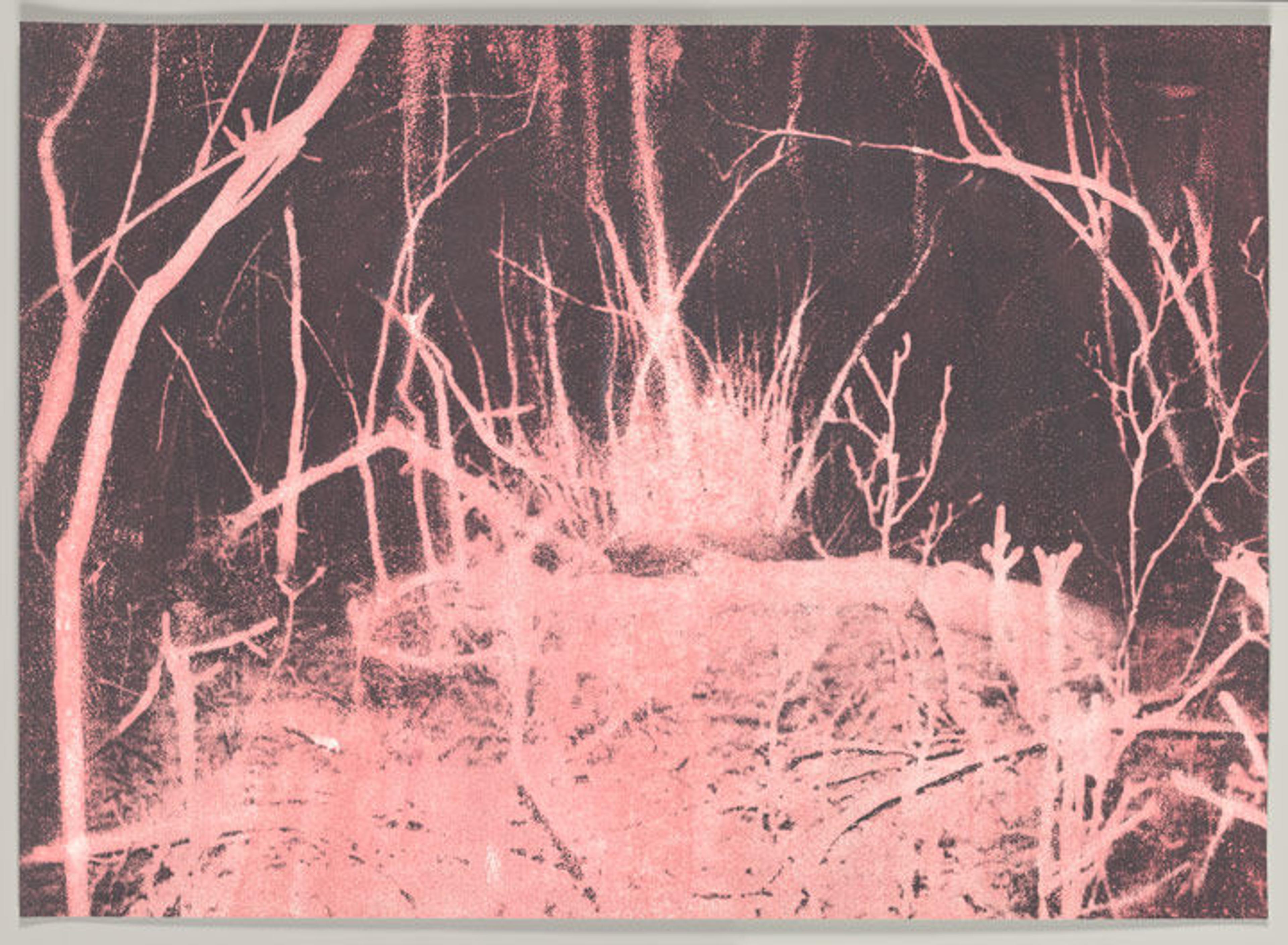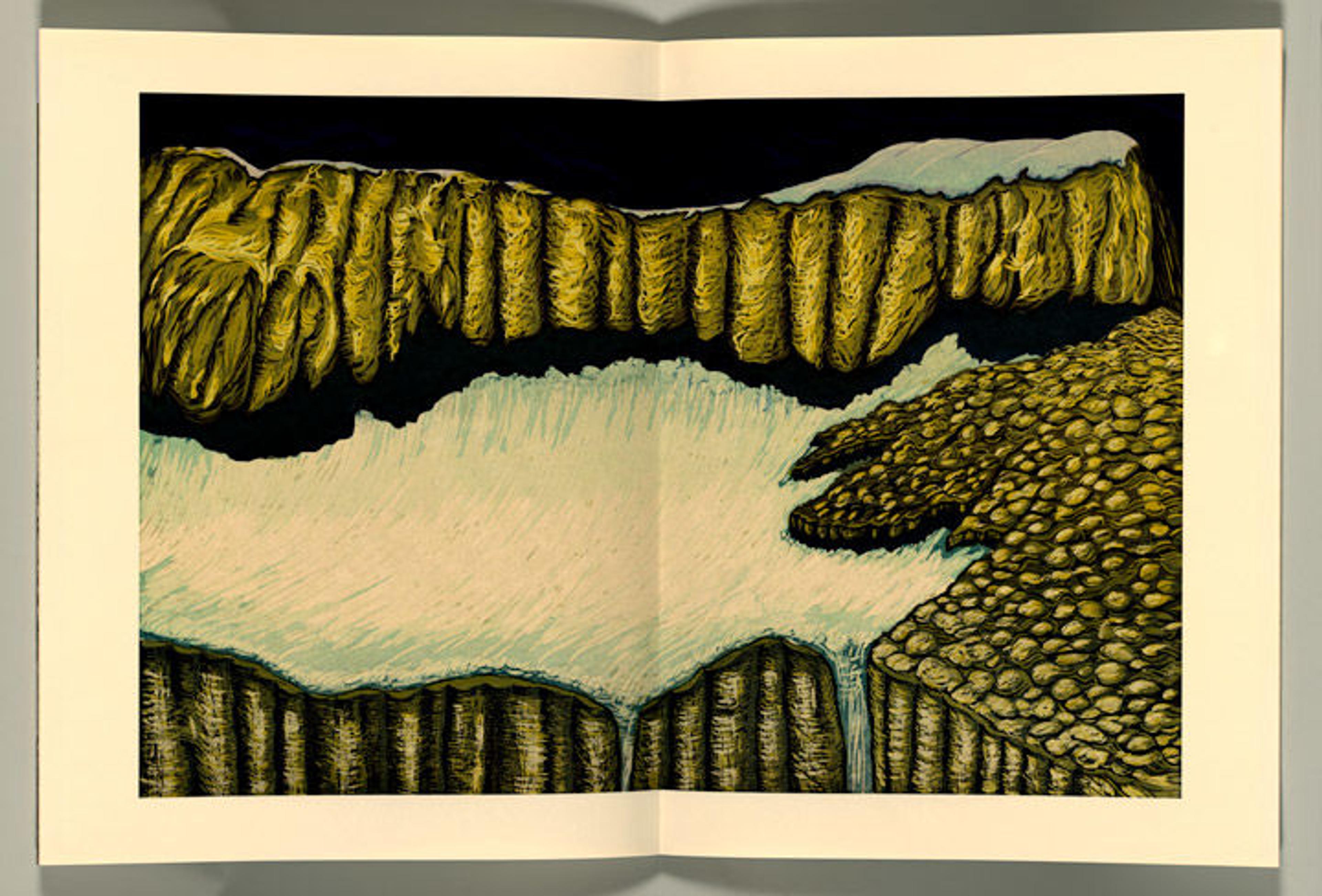«On view through February 5 in Selections from the Department of Drawings and Prints: Lagoons to Monsoons is a selection of recently acquired contemporary works, all of which are making their debut at The Met. While each artist included in the rotation employed a wide variety of techniques and materials, and are not united in a single style or approach, a topic many addressed in many of these works was that of an environment under assault.»

Matthew Day Jackson (American, born 1974). There Will Come Soft Rains, 2015–16. Portfolio of four-color, four-plate etchings, each sheet: 27 in. x 20 1/2 in. (68.6 x 52.1 cm). The Metropolitan Museum of Art, New York, John B. Turner Fund, 2016 (2016.356a–m)
Matthew Day Jackson's There Will Come Soft Rains is a portfolio of 12 prints featuring images from John James Audubon's seminal Birds of America series. In 2013, Jackson and Chris Creyts (the founder of and master printer at Collaborative Art Editions, which produced and published There Will Come Soft Rains) acquired the copper etching plates made in the 1930s for an edition to be published by the Audubon Society. The edition was never realized, however, and the plates remained untouched until Jackson and Creyts used them for this work.
Jackson chose a dozen of Audubon's iconic images of different species of birds from North America and, in an unintended twist, discovered that three of the birds featured—the carrier pigeon, the Carolina parakeet, and the ivory-billed woodpecker—may now be extinct due to slaughter and loss of habitat. Rather than depicting them in their natural environment as Audubon had done in great detail, Jackson layered bold, acidic colors and images derived from a variety of sources and time periods to create doomsday scenarios.
Featuring details from Peter Brueghel the Elder's painting The Triumph of Death, as well as stills from Disney movies, newspaper photographs of a Ukrainian amusement park suddenly abandoned after the 1986 Chernobyl disaster, mid-century skyscrapers photographed by Herman Landshoff, images of the 1967 riots in Newark from Life magazine, and film stills depicting the end of the world, these apocalyptic scenes correspond to 12 disasters that include global warming, industrial pollution, overpopulation, nuclear war, social collapse, medical epidemics, as well as the potential devastating effects that could be caused by asteroids and the death of the sun. Yet despite the carnage and destruction, the birds go about their business, oblivious to mankind's demise, a theme reinforced by the Sara Teasdale poem from which the series takes its name.
In her poem, Teasdale described nature reclaiming the world after the end of civilization. A version of the poem first appeared in the July 1918 issue of Harper's Monthly magazine; later subtitled "War Time," it was published while World War I raged and evokes the destructive potential unleashed by the first modern industrial war. In 1950, Ray Bradbury wrote a short story of the same name that makes reference to, and quotes from, Teasdale's poem to describe an American town obliterated by a nuclear bomb.
Below the images, Jackson hand-stamped a stanza from Teasdale's poem on each print:
There will come soft rains and the smell of the ground,
And swallows circling with their shimmering sound;
And frogs in the pools singing at night,
And wild plum trees in tremulous white,
Robins will wear their feathery fire
Whistling their whims on a low fence-wire;
And not one will know of the war, not one
Will care at last when it is done.
Not one would mind, neither bird nor tree
If mankind perished utterly;
And Spring herself, when she woke at dawn,
Would scarcely know that we were gone.

Glen Baldridge (American, born 1977). Hideaway, 2013. Watercolor, powdered graphite, and screenprint, sheet: 26 3/4 x 37 1/2 in. (67.9 x 95.3 cm). The Metropolitan Museum of Art, John B. Turner Fund, 2015 (2015.791)
Glen Baldridge's Hideaway also presents an image of nature made uncanny. This haunting and isolated wooded landscape is based on a photograph the artist took at night in rural New England with a hidden motion-activated game camera. Triggered by animals, people, wind, rain, and other natural forces, such cameras capture grainy images of things that normally go unnoticed. Made with watercolor, powdered graphite, and screenprint on handmade paper, Hideaway evokes myriad associations, many of which—surveillance, the supernatural, horror films, heavy-metal music, gothic fairy tales—have sinister associations and connote danger. At the same time, Hideaway also recalls earlier depictions of forests, such as those found in German art—in particular the wooded scenes found in the work of the northern Renaissance artist Albrecht Dürer (1471–1528), a figure Baldridge often cites as an inspiration.

Ranjani Shettar (Indian, born 1977). Varsha, 2012. Artist's book, box: 12 1/8 x 15 7/8 in. (30.8 x 40.4 cm); cover: 11 1/4 x 15 1/4 in. (28.6 x 38.7 cm); sheets: 11 1/4 x 14 13/16 in. (28.6 x 37.6 cm). The Metropolitan Museum of Art, New York, Gift of Lin Lougheed, 2016 (2016.587.44)
By contrast, Ranjani Shettar used a variety of materials and techniques—including etching, screenprint, woodcut, and laser cut—in her artist's book Varsha ("rain," or the rainy season in the Hindu calendar) to create images that evoke the 16 phases of monsoon season and the aspects of Indian astronomy credited with governing this annual event. Dramatic tonal contrasts recall darkening skies and bursts of sunlight, while brightly colored floral motifs such as water lilies refer to lush vegetation. The constellations, based on ancient Indian star charts, are represented in patterns that correspond to the six-month monsoon period.

Todd Anderson, Bruce Crownover, and Ian van Coller. The Last Glacier, 2015. Artist's book of 23 image plates with 13 reductive woodblock prints on Okawara, and 10 photographic pigment prints on Asuka, dimensions when opened: 25 x 38 in. (63.5 x 96.5 cm). The Metropolitan Museum of Art, New York, John B. Turner Fund, 2017 (2017.149)
Also engaging environmental shifts is The Last Glacier. The work—an artist's book made by Todd Anderson, Bruce Crownover, and Ian van Coller in 2015—is both an artistic response to and historical record of the dramatic peaks and valleys found at Glacier National Park, considered to be among the crown jewels of America's national park system. Comprising reductive woodblock prints and photographic pigment prints, the book reflects an effort to document and respond to climate-related topographical changes and the site's disappearing glaciers, which the United States Geological Survey predicts will vanish by 2020. In style and technique, the artists reveal influences such as Japanese ukiyo-e prints and landscapes realized in a variety of media by 19th-century artists.
![Sarah Sze's 'Untitled [Day]' (top) and 'Night' (bottom), two lithographs with abstract designs](https://cdn.sanity.io/images/cctd4ker/production/85727d5353f2701433f4cf6512fb8469c9203f56-720x795.jpg?w=3840&q=75&fit=clip&auto=format)
Top: Sarah Sze (American, born 1969). Untitled [Day], 2001–3. Lithograph in colors with screenprint, sheet: 37 3/4 in. x 71 in. (95.9 x 180.3 cm). The Metropolitan Museum of Art, New York, John B. Turner Fund, 2017 (2017.126). Bottom: Sarah Sze (American, born 1969). Night, 2003. Lithograph in colors with screenprint, sheet: 37 3/4 in. x 71 in. (95.9 x 180.3 cm). The Metropolitan Museum of Art, New York, John B. Turner Fund, 2017 (2017.127)
By contrast, Sarah Sze's dynamic oversized prints Untitled [Day] and Night reflect on man-made constructions as well as the space in which her work is encountered. Whether in prints composed of intricately layered images such as these, or elaborate assemblages created with such humble everyday objects as Q-tips, paper envelopes, plastic water bottles, plants, and ladders, Sze uses her work to explore a range of issues, including value, memory, and perception. In Untitled [Day] and Night, the artist conveys a poetic power and sense of disorientation similar to that found in her assemblages, yet in two-dimensional form. Using screenprint, lithography, and digital elements, she layers delicate architectural drawings, art-historical references, cosmological details, and renderings of infrastructure, which, when combined with abstract elements, create constellations that seem to expand beyond the confines of the frame. The artist addressed the union of these disparate images, themes, and modes of representation, stating:
These works investigate movement, disintegration, and disorientation. . . . I wanted to enter a two-dimensional frame and find a location that is entropic, fragmenting, spinning, and adrift. . . . They start from an exploration of atmosphere, fleeting situations, and environments with a specific kind of weather.
Both Untitled [Day] and the later Night reflect a similar engagement with form, scale, motion, and environment; from a distance, the more abstract elements dominate, yet a closer inspection reveals finely rendered architectural details as well as helicopters, birds in flight, and other recognizable things.
Related Link
Selections from the Department of Drawings and Prints: Lagoons to Monsoons, on view at The Met Fifth Avenue through February 5, 2018